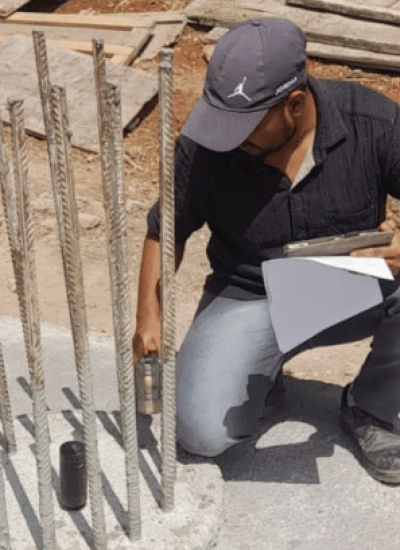Non Destructive Testing
Non Destructive Testing
Rebound Hammer
The difficulties of core cutting, making, curing and testing of standard test specimens can be avoided if concrete strength can be tested at the site in a manner harmless to the part of the concrete under test. One such method that has found practical application with a limited scope is known as the Rebound Hammer Test devised by Ernst Schmidt.
It is also known as impact hammer or Sclerometer test. Rebound hammer test is done to find out the compressive strength of concrete by using rebound hammer as per IS: 13311 (Part 2) – 1992. The underlying principle of the rebound hammer test is The rebound of an elastic mass depends on the hardness of the surface against which its mass strikes.
When the plunger of the rebound hammer is pressed against the surface of the concrete, the pring-controlled mass rebounds and the extent of such a rebound depends upon the surface hardness of the concrete. The surface hardness and therefore the rebound is taken to be related to the compressive strength of the concrete.
The rebound value is read from a graduated scale and is designated as the rebound number or rebound index. The compressive strength can be read directly from the graph provided on the body of the hammer.
- Lorem Ipsum is simply
- Printing and typesetting
- Has been the industry
- Printing and typesetting
- Lorem Ipsum is simply
- Has been the industry

IS Codes applicable: As per IS 13311. (Part 1): 1992
Applications of the test:
The test is performed on structural elements.
Homogeneity of Concrete.
Presence of Cracks, Voids & Other Imperfections.
Changes in Concrete Structure with time.
Velocity co-related to strength.
Equipment Used:
Electric Pulse Generator.
Transducer: One Pair.
Amplifier.
Electronic Timing Device.
Test basis:
Ultrasonic pulses travel faster in denser material. Each material has typical ultrasonic pulse velocities.
E.g. steel, Concrete etc. using benchmarks over a period of time and conducting extensive laboratory and in-situ tests, we have co-related ultrasonic pulse velocity and estimated strength.
Methodology:
- Assess access, Single sided, double sided etc on the structural element Clean the concrete surface thoroughly (on plaster or without plaster).
- Apply grease on the concrete surface where test is to be conducted.
- Press probes on the surface of the structural element to remove air gaps.
- Note down the distance between the 2 probes.
- Read time taken for the ultrasonic pulse from the instrument.
Calculate Velocity = distance / time
- Repeat the test on multiple areas of the element if necessary.
- Test at different members of the structure.
Other Services
Aggregate Testing
Adhesive Testing
Water Testing
Soil Testing
This laboratory is best of concrete testing this is nabl good service and good behavior every staff and senior person
Anand Kumar
Best Material Testing Laboratory!
SKG Project & Engg. Pvt. Ltd., have a state of art Material Testing Laboratory.
